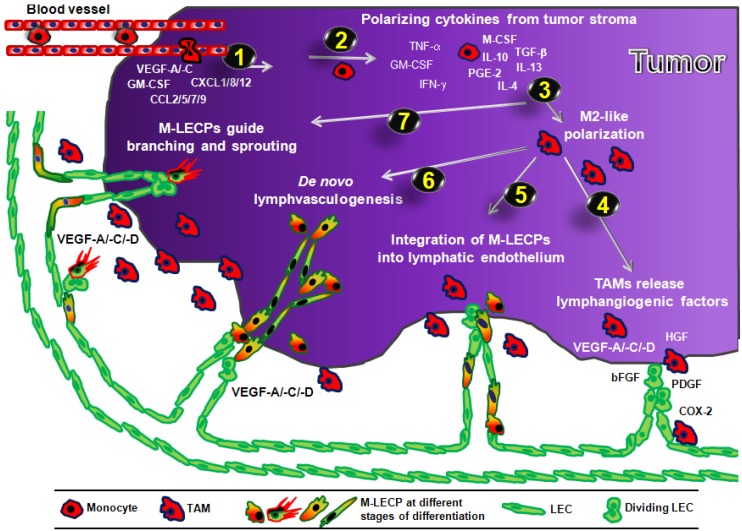Figure 1.
Potential roles of TAMs and macrophage-derived LECP in tumor lymphangiogenesis. Schematic representation of known and potential roles of tumor-associated macrophages that can promote lymphangiogenesis. (1) Tumors produce many chemotactic agents such as CCL2, GM-CSF, CXCL1, and VEGF-A that recruit macrophages from circulation or adjacent tissues; (2) Monocytes mature into macrophages in response to activating cytokines secreted by tumors. These include cytokines associated with the M1/Th1 immune response such as TNF-α, GM-CSF, and INF-γ; and those related to the M2/Th2 immune response including IL-10, TGF-β, and M-CSF; (3) Tumor cytokine milieu polarizes macrophages towards the pro-tumorigenic M2 phenotype (TAMs) that has been correlated with LN metastasis in humans (Table 2); (4) TAMs stimulate lymphangiogenesis in a paracrine manner by producing multiple lymphangiogenic factors that stimulate proliferation and migration of LEC (Table 2); (5) TAMs have been shown to differentiate into M-LECP (Table 3) and structurally contribute to the tumor lymphatic endothelium (Table 5); (6) In inflammatory models, M-LECP have been shown to coalesce and form de novo lymphatic vessels suggesting that a similar process might occur in tumors; (7) M-LECP have been also shown to incorporate into chord structures at branch points and at the tips of growing sprouts in vitro suggesting that they guide branching and sprouting [23]. By a similar mechanism, M-LECP might guide the growing tips of lymphatic sprouts while migrating towards a chemo-attractant produced by the tumor.

